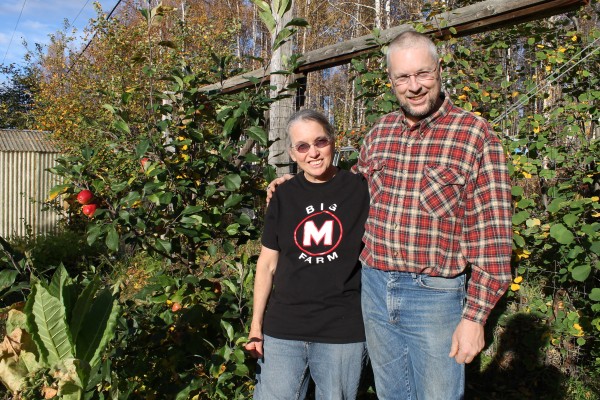Johansons grow an ecosystem
September 23, 2014

Nancy Tarnai
907-474-5042
9/23/14
Vic and Edna Johanson have created a little piece of Eden at their property off Chena Hot Springs Road.
This is not a manicured, orderly, precise paradise; instead it’s somewhat chaotic, but it produces a bounty of homegrown fruit, veggies, eggs and meat. “It’s not a farm; it’s an ecosystem,” Vic Johanson said.
“What I’m really trying to do is be a hunter/gatherer without having to leave my yard.”
Johanson, whose day job is information technology at Fairbanks Memorial Hospital, enjoys growing everything. “People think what we can grow is limited but there is no end to it,” he said, sauntering through his gardens laden with fruit trees and all manner of plants.
“Any time I hear of something that might grow I try to get it.”
Johanson gets varying results from his grafting experiments. Some trees bear different varieties of fruit, making for a spectacular display. One tree alone has seven kinds of apples. He not only knows the names of all the plants, he recalls who he got them from.
“I break all the rules,” he said. Although he started out planting on a grid he decided to follow a more Bohemian path. “There are not so many straight lines,” he said. And he doesn’t worry about weeds, insects or voles, but accepts them as part of the package. He doesn’t even prune the fruit trees. “I’m observing,” he said. “It’s all an experiment.”
Johanson strives for an integrated setup where plants grow in communities, just as they do in nature. The self-taught farmer grew up in Tampa, Florida, and Edna near New Orleans. They both served in the U.S. Army and met at a Bible college in St. Louis. They joined a religious sect which took them on many detours but eventually led them to Fairbanks in the 1980s.
After reading an article in the News-Miner about a man growing apples, Johanson tracked him down and knocked on his door to get a sapling.
“It’s mostly an obsession,” Johanson said.
The land is laden with apple, pear, cherry, plum and walnut trees, ordinary garden vegetables, kiwi vine, Jerusalem artichoke, Valerian root, red and yellow raspberries, gooseberries, Saskatoons, stinging nettle, horseradish and grains. Plants that like warmer settings, like tomatoes, grow in 34 re-purposed bathtubs.
“This is my test laboratory,” Johanson said. His plan is to figure out what works, then start a new farm on 48 acres the couple owns near Steele Creek. “I’m in the phase of gathering knowledge and germplasm so I can duplicate natural systems. I’m going for biodiversity.” He shares seeds and ideas in a network of growers. “I track down things that are not very well known; there are lots of obscure things.”
The soil is so rich it is filled with earthworms galore. Johanson is experimenting with “Hugulkultur,” a European method of mound cultivation. Decomposing wood pieces inside the mounds create heat, and the soil fills with microbes. The method is so successful that potatoes planted in the mounds weigh as much as three pounds each.
Beehives are set up along the edge of the garden, but Johanson doesn’t like the traditional Fairbanks practice of killing bees each winter and ordering new ones from the lower 48 in the spring. He lets the bees do their thing and if they die then he takes the honey. “It’s awesome to have them around to pollinate,” Johanson said. “I would like to find a sustainable way to keep them because I’m not interested in killing them.”
The Johansons raised two children and now have four grandchildren who love to help in the garden and pick apples. Edna, a substitute teacher, is in charge of raising the chickens and turkeys, leaving Vic to the horticulture.
Johanson’s goal is to figure out a way to make a living off the land, providing food that locals probably won’t find elsewhere. “I’m always scouring plants for the next weird thing,” he said.
Since he doesn’t often take advice from others, Johanson was hesitant to give any, but finally said, “Go for diversity. There is more and more demand for healthy, locally produced food. It’s exciting.”


